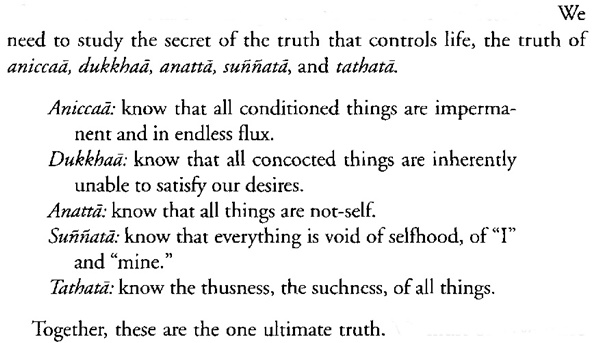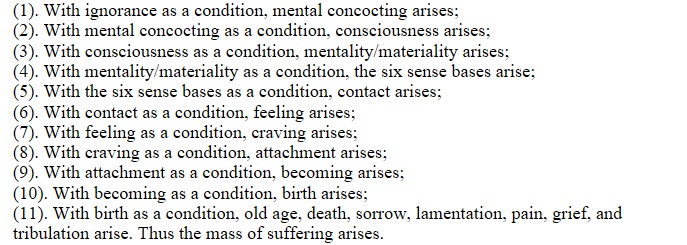|
ZANDTAOMED MANUAL
Email Zandtao:- |

|
ZANDTAOMED MANUAL
|
|

|
|
|
App F - Tathata, Timeless and Tacit The wisdom of the Buddha is timeless but let’s be clear where this timelessness lies. It lies beyond. The Buddha had followed the path and gone beyond. Let’s examine this description of the path:-  and start with the path to end suffering. At the time of the Buddha there was a world of suffering, first Noble Truth, and the Buddha’s path ended his suffering. We live in a world of suffering but it is not the same world. The Buddha’s timeless wisdom takes us beyond the current world of suffering, even though it is a different world. In the Handbook for Mankind Buddhadasa describes Buddhism as “nothing other than this perfection of knowledge of what is what or the true nature of things [p39 of 203]”. The true nature of things is the world of suffering, but that true nature is more than that. To fully understand this true nature we need wisdom and so we work towards the wisdom of the Buddha, the Buddha's timeless wisdom. Even though I do not know the suttas I accept that Venerable Buddhadasa did, and I take my understanding from him - even though I only know some of what he taught. Buddhadasa knew the Buddha knew the nature of things when he was alive. He knew that the Buddha’s teachings were timeless wisdom because he was the Buddha, and the Buddha knew what is what - not just the timeless wisdom. Assessing history and the political reality of the kingdoms, the Buddha was able to determine the timeless wisdom that is included in the suttas. What is not included in the suttas is the historical and political assessment that the Buddha had needed to understand, because the suttas were written just to include the teachings for wisdom. The Buddha’s understanding included these historical and political understandings but those understandings were tacit – the intention of the suttas was to contain the timeless wisdom. The second description of the path is going beyond conditioning. To be wise and go beyond conditioning we have to understand the nature of conditioning. In the same vein there is a timeless and tacit conditioning. The timeless conditioning is explicit – the conditioning that comes from instinct, that comes from kaya, vedana and citta, that comes from the 5 khandhas. But there is a second conditioning that develops from the explicit. The explicit conditioning is natural based on instinct and the need for survival, but in adulthood this explicit conditioning is meant to fall away. But there is a similar conditioning that comes from the tacit – the historical and political conditioning of the time we live in, when we look at this societal conditioning we can see the way natural conditioning is perpetuated within society so rather than falling away naturally as intended this conditioning pervades society preventing people from following their paths. To go beyond conditioning we have to understand any conditioning that results from the time we live in – to understand the tacit as well as understanding the explicit conditioning that is usually discussed to achieve atammayata. The timeless wisdom tells us to develop mindfulness because with mindfulness we can “watch and wait, to examine in the manner described the suffering that comes to one – this is very best way to penetrate to Buddha Dhamma [p49 of 203]”. We develop mindfulness to go beyond the explicit and tacit conditioning so that we have the mindfulness to understand timeless wisdom. Mindfulness has to know the history and politics of the tacit in order to move beyond the conditioning the society tries to control us with – sadly for many of us conditioning does control us. To know what is what is to know the timeless and the tacit. How can we understand the timeless wisdom without understanding the context in which that wisdom occurs? To know what is what is to understand both the timeless and tacit, if we know both then we can know the timeless and being wise is what matters. In the suttas we find what the Buddha taught about knowing what is what, but there is not specific talk about the tacit because that is not timeless. To understand the timeless the tacit has to be understood, without understanding the tacit how can we arrive at the timeless? In MwB Buddhadasa teaches what arises by following the 4 tetrads:-  Tathata, knowing the suchness of all things, arises out of meditation - anapanasati-bhavana. Buddhadasa taught that the tacit understanding that I mentioned above usually arises out of meditation. Knowing what is what, tathata, is both the timeless wisdom and the tacit historical and political understanding of society, and it arises from the clear mind of meditation; tathata is both the timeless wisdom and the tacit understanding. For us to know how to use the timeless wisdom that follows from the Buddha's teachings, we must be able to contextualise the wisdom with the tacit understanding of the way society is; this comes from developing tathata through MwB. Do we then express this tacit understanding? What we need to consider is what is right view here. Once a social view is expressed it causes division, once we express view of society there is the risk of clinging - ditthupadana. The right view is not concerned with expressing the tacit understanding but recognising that our path is to connect to the Dhamma - as practised with MwB. Recently the Buddhadasa BIA Bkk page made this post so I will start from there to develop an approach for understanding the timeless and the tathata. Here is the question, a Q&A that has many levels and an issue that has many more; the pathtivism Manual is primarily about this issue. “Do you think that working for inner peace and enlightenment needs to be supplemented by engaged Buddhism or working for world peace, by challenging the structures that oppress – e.g. armies, governments, religions, bigotry – through non-violent actions?” ? “Do you think that working for inner peace and enlightenment needs to be supplemented by engaged Buddhism?” Basically Buddhadasa’s answer to this is no with an explanation:- “The Dhamma itself will bring about a revolution in our hearts, and then through that inner spiritual revolution one will practice, one will live and work, not only for one’s own benefit, but for the benefits of society. “The Dhamma exists in order to resolve conflict. Because human beings were already in conflict, already fighting and so on, it became necessary to discover Dhamma. If one has sufficient Dhamma there would be no conflict.” I 100% support this answer. Having worked in the movement without sufficient emphasis on the Dhamma – both in myself and amongst activists, I know that the movement is weaker because of this lack of connection. Current conflicts within the movement are exacerbated because activists do not emphasise Dhamma. How some activists work with existing establishment is conflictual primarily because they themselves have not matured, and this immaturity is used by the establishment to ignore pertinent issues. This, on one level, is answered by “If one has sufficient Dhamma there would be no conflict.” It is not the promotion of a view but the development of sufficient Dhamma that will bring about a "revolution in our hearts". Through MwB or otherwise we develop the tathata which includes both the timeless wisdom of the Buddha's teachings and the tacit understanding of society to contextualise that wisdom. But how we develop this wisdom depends on our individual paths and does not require us to conform to particular views. But this tathata includes the understanding of idappaccataya-paticcasamuppada, nature and its laws including the law of how conditioning arises:- Dhammajati - nature and its laws:-  and the law of dependent co-arising:-  Based on these fundamental laws how our path and our compassion assesses the tacit societal understanding is our own concern - your concern. However what must be understood is that attempting to find this understanding cannot be ignored, it is part of our path in developing tathata; and we develop that tathata by developing Dhamma. From this I conclude that we must be 100% engaged but that does not mean carrying placards 100% of the time. 100% engagement requires that we understand that for our path we have sufficient understanding of engagement with daily life on the path our authenticity takes us. But it is our Dhamma that guides us, our compassion that directs, and not subscribing to a particular view. But there must be some activism, we cannot understand daily life and the way society responds without being active in terms of our path. Through activism we understand the delusion that the world is not the way it says it is, but the way it is. Compassion brings with it a duty for action so you are left with the pathtivist dilemma – what action is right? And there are no universal answers. Well there are two but they are not the simple plan of action those without mindfulness want instructions for:- From the 4NT we know there is a world of suffering and from paticcasamuppada we know this world comes from conditioning. But how does this suffering show in the world? In other words what teachings did the Buddha give us to understand the world of suffering? Conditioned egos occur because we attach and cling to desires – 4NT. But how does this clinging show? In the world this shows as defilements (kilesa) so if we look at the defiled world we can see greed, delusion and aversion. The kilesas are usually considered on a personal level, in that we are asked personally to remove the kilesas, to remove the egos that give rise to kilesa. But we can also see in the defiled world the collective kilesa. What is perhaps more important is that we can use the kilesa to explain forces in the defiled world to then show us the importance of removing kilesa in ourselves and hopefully encourage others to remove kilesas to help improve the state of the defiled world. Understanding what the kilesas are was part of the timeless wisdom the Buddha gave us in order to see the world for what it is. Kilesas are the timeless wisdom to help us understand the tacit. In our world today we can understand the tacit through examining the defiled world in terms of greed, delusion and aversion, and thus we can follow the path by removing these defilements in ourselves. When considering our current defiled world few dispute that greed is a problem. However little emphasis is placed on the other two kilesa as contributors to our world situation. That is the wisdom of the Buddha by showing us that we not only need to look at greed but also the way delusion and aversion affects our daily lives. Humanity is easily fooled through delusion, to maintain this the kilesa of aversion helps people accept the delusion and avoid the truth. How do you recognise this defilement? To understand our defiled world we use the wisdom keys the Buddha gave us for that understanding by seeing the world in terms of the kilesa - greed, aversion and delusion. At 67 I can look back in my life and see that the world I have lived in has been defiled by these three, and there is no reason to think that such defilements have not given rise to defiled worlds throughout history. It is your duty to examine your world to see the kilesas and remove greed, delusion and aversion; to avoid explicit views it is your responsibility to see the world clearly - with developed tathata. If we use the keys of the kilesa we can see how the defiled world arises, and therefore it would be in line with accepting the Buddha’s teachings to completely engage in the removal of the defilements, not only for ourselves but also to help others to remove their defilements in an attempt to create a world that is not so defiled. Whether this complete engagement is through compassion on a personal level or in other ways, compassion requires complete engagement in line with the Buddha’s timeless wisdom concerning the path, and his timeless wisdom of the kilesa that leads to a tacit understanding of the world of suffering enabling us to develop our own wisdom that is beyond the “tacit”. Meditation - There is a hermetic principle "as above so below" - maybe as for the microcosm so for the macrocosm, but in this case we have the defiled world and the kilesa in us. If as I am suggesting the Buddha looked at the world and saw kilesa so can we. This is tathata - what is what. But in this world each individual must take care of themselves so as the world is conditioned by kilesa then around us must be this conditioning of kilesa. We are subject to the conditioning of kilesa. Daily the kilesa try to attract our egos building up attachments so mindfulness needs to be aware of this. Daily mindfulness must seek greed, delusion and aversion, and let go of their attachments. This needs to be part of our meditation practice. We must be humble. Any compassionate person must say I am not greedy, yet there is the conditioning of greed all around us. Any mindful person must say I am not deluded, yet there is the conditioning of delusion all around us. Any meditator must say I look inside myself yet there is the conditioning of aversion all around us - perhaps as complacency? For the pathtivist with complete engagement in this world there has to be constant awareness of the kilesa, in our meditation we must not be complacent. Look for greed, aversion and delusion and let go of the egoic attachment. Now let us return to the Buddha and his timeless wisdom, what did he promote? The Three Refuges - Buddha, Dhamma, Sangha. Let us start with the word "refuge" - definition "a condition of being safe or sheltered from pursuit, danger, or trouble"; the word refuge has a sense of temporariness about it. I raise the question of what is temporary and what is permanent of the 3 Refuges? The Buddha's wisdom is timeless - that is a permanent aspect of the first Refuge. What about the Sangha? The Sangha with its monastics and its shelter provides 2 functions:- This fits in with an understanding of Dhamma, that I want to put forward - sampajanna, one of the 4 Dhamma comrades from MwB, is the application of wisdom in daily life - the application of the timeless in the tacit. In general what is the purpose of teaching - of education? To live a wise life - the Buddha's wisdom in practice - part of the second Refuge - sampajanna, the Dhamma comrade. Whilst teachers and a temporary refuge are essential in such a defiled world, the objective of studying Buddhism is not to learn what is what, and put on orange robes. The Buddha learned and then gave us his wisdom, to help us live better lives - Dhamma, providing us with teachers, Sangha - and a temporary refuge. If we take refuge in the Three Refuges as just described, then the issue of Right Action in daily life completely resolves the issue of whether there is wise engagement. This also gives an understanding to the Bodhisattva Vow:-  For many the Bodhisattva Vow is wrapped up in reincarnation where enlightened beings "Bodhisattvas promise to practice the six perfections of giving, moral discipline, patience, effort, concentration and wisdom in order to fulfill their bodhicitta aim of attaining enlightenment for the sake of all beings [wiki - Bodhisattva Vow]". But take it out of a reincarnation context and you have an imperative for wise engagement as can be seen from Thay's meme (and discussed by Thay here). The Bodhisattva Vow is not concerned with increasing the size of the Sangha per se but applying the Dhamma to daily life. Without understanding the complete disenchantment of daily life, we cannot transcend into a state of understanding that allows us access to the timeless wisdom. But once we have reached an understanding of the timeless wisdom, then there is a natural duty to apply that wisdom into enchanting daily life. To me this is a consequence of understanding the Three Refuges and the Boddhisattva Vow, applying the timeless in the world of the tacit(cute? |